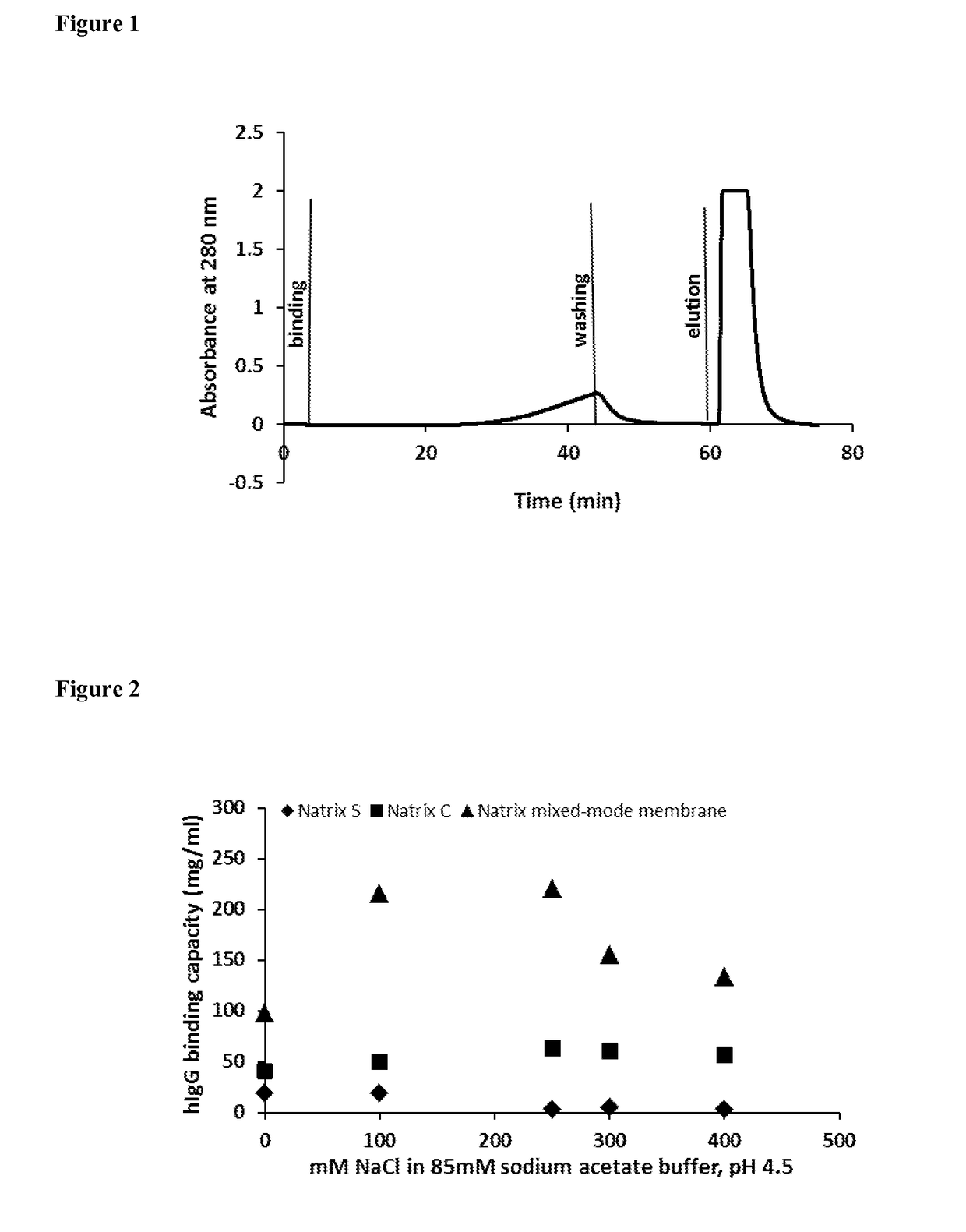Mixed-mode chromatography membranes
a chromatography membrane and mixed-mode technology, applied in the field of multi-modal chromatography, can solve the problems of product aggregation or precipitation, high price, and account for a significant component of the cost of goods
- Summary
- Abstract
- Description
- Claims
- Application Information
AI Technical Summary
Benefits of technology
Problems solved by technology
Method used
Image
Examples
example 1
[0255]This example illustrates a method of preparing a cation-exchange material of the present invention with multi-modal functionality.
[0256]A 20 wt % solution was prepared by dissolving 2-carboxyethyl acrylate, 2-acrylamido-2-methyl-1-propanesulfonic acid, ethylene glycol phenyl ether methacrylate, 2-(methylthio) ethyl methacrylate in a molar ratio of 1:0.22:0.14:0.06, respectively, in a solvent mixture containing 27.0 wt % N,N′-dimethylacetamide, 61.0 wt % di(propylene glycol)dimethyl ether, 7.15 wt % 1,2-propanediol and 4.85 wt % water. Glycerol 1,3-diglycerolate diacrylate was used as a cross-linking agent to achieve cross-linking density of 8% (mol / mol). The photo-initiator Irgacure 2959 was added in the amount of 1 wt % with respect to the mass of the monomers.
[0257]A composite material was prepared from the solution and the support TR0671 B50 (Hollingsworth & Vose) using the photoinitiated polymerization according to the following general procedure. A weighed support member ...
example 2
[0265]This example illustrates a method of preparing a cation-exchange material of the present invention with multi-modal functionality
[0266]A 23 wt % solution was prepared by dissolving 2-carboxyethyl acrylate, 2-acrylamido-2-methyl-1-propanesulfonic acid, ethylene glycol phenyl ether methacrylate, hydroxypropyl methacrylate in a molar ratio of 1:0.25:0.15:0.14, respectively, in a solvent mixture containing 26.3 wt % N,N′-dimethylacetamide, 59.6 wt % di(propylene glycol)dimethyl ether, 7.3 wt % 1,2-propanediol and 6.8 wt % water. Glycerol dimethacrylate (GDA) and 3-(acryloyloxy)-2-hydroxypropyl methacrylate (AHM) were used as cross-linking agents to achieve cross-linking density of 10.6% (mol / mol). Cross-linking agents GDA and AHM were added in a molar ratio of 1:0.9, respectively. The photo-initiator Irgacure 2959 was added in the amount of 1 wt % with respect to the mass of the monomers.
[0267]A composite material was prepared from the solution and the support TR0671 B50 (Hollings...
example 3
[0270]This example illustrates a method of preparing a cation-exchange material of the present invention with multi-modal functionality
[0271]A 20.6 wt % solution was prepared by dissolving 2-carboxyethyl acrylate, 2-acrylamido-2-methyl-1-propanesulfonic acid, ethylene glycol phenyl ether methacrylate in a molar ratio of 1:0.26:0.15, respectively, in a solvent mixture containing 27.0 wt % N,N′-dimethylacetamide, 60.0 wt % di(propylene glycol)dimethyl ether, 6.5 wt % 1,2-propanediol and 6.5 wt % water. Glycerol propoxylate (1PO / OH) triacrylate was used as cross-linking agents to achieve cross-linking density of 7.7% (mol / mol). The photo-initiator Irgacure 2959 was added in the amount of 1 wt % with respect to the mass of the monomers.
[0272]A composite material was prepared from the solution and the support TR0671 B50 (Hollingsworth & Vose) using the photoinitiated polymerization according to the general procedure described above (Example 1). The sample was irradiated for 10 min at 350...
PUM
| Property | Measurement | Unit |
|---|---|---|
| concentration | aaaaa | aaaaa |
| pore diameter | aaaaa | aaaaa |
| diameter | aaaaa | aaaaa |
Abstract
Description
Claims
Application Information
 Login to View More
Login to View More - R&D
- Intellectual Property
- Life Sciences
- Materials
- Tech Scout
- Unparalleled Data Quality
- Higher Quality Content
- 60% Fewer Hallucinations
Browse by: Latest US Patents, China's latest patents, Technical Efficacy Thesaurus, Application Domain, Technology Topic, Popular Technical Reports.
© 2025 PatSnap. All rights reserved.Legal|Privacy policy|Modern Slavery Act Transparency Statement|Sitemap|About US| Contact US: help@patsnap.com



